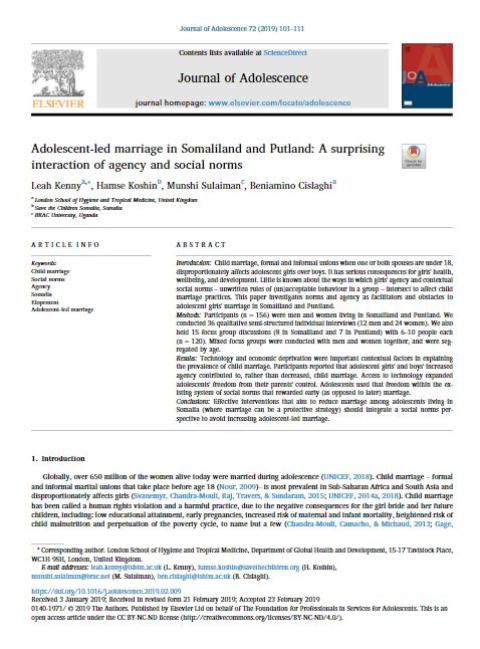- Journal article
- 9 Febrero 2019
Adolescent-led marriage in Somaliland and Putland: A surprising interaction of agency and social norms
- Author: Leah Kenny et al.
- Published by: Elsevier

Abstract
Introduction
Child marriage, formal and informal unions when one or both spouses are under 18, disproportionately affects adolescent girls over boys. It has serious consequences for girls' health, wellbeing, and development. Little is known about the ways in which girls' agency and contextual social norms – unwritten rules of (un)acceptable behaviour in a group – intersect to affect child marriage practices. This paper investigates norms and agency as facilitators and obstacles to adolescent girls' marriage in Somaliland and Puntland.
Methods
Participants (n = 156) were men and women living in Somaliland and Puntland. We conducted 36 qualitative semi-structured individual interviews (12 men and 24 women). We also held 15 focus group discussions (8 in Somaliland and 7 in Puntland) with 6–10 people each (n = 120). Mixed focus groups were conducted with men and women together, and were segregated by age.
Results
Technology and economic deprivation were important contextual factors in explaining the prevalence of child marriage. Participants reported that adolescent girls' and boys' increased agency contributed to, rather than decreased, child marriage. Access to technology expanded adolescents' freedom from their parents' control. Adolescents used that freedom within the existing system of social norms that rewarded early (as opposed to later) marriage.
Conclusions
Effective interventions that aim to reduce marriage among adolescents living in Somalia (where marriage can be a protective strategy) should integrate a social norms perspective to avoid increasing adolescent-led marriage.
- Tags:
- Child marriage
- Countries / Regions:
- Africa